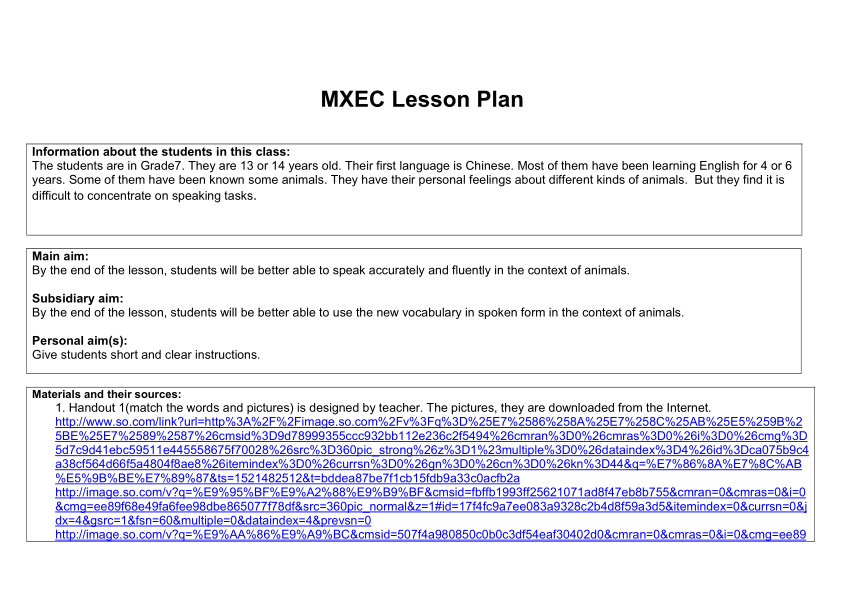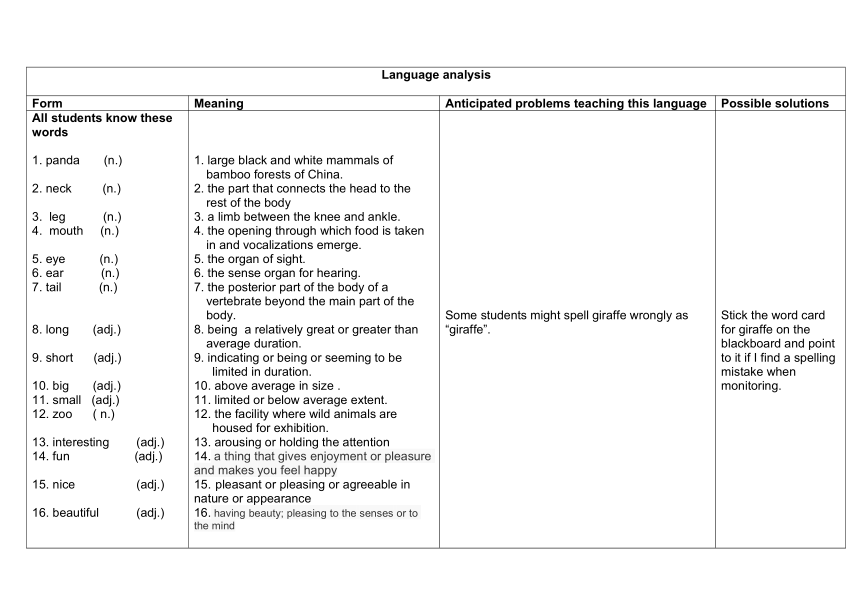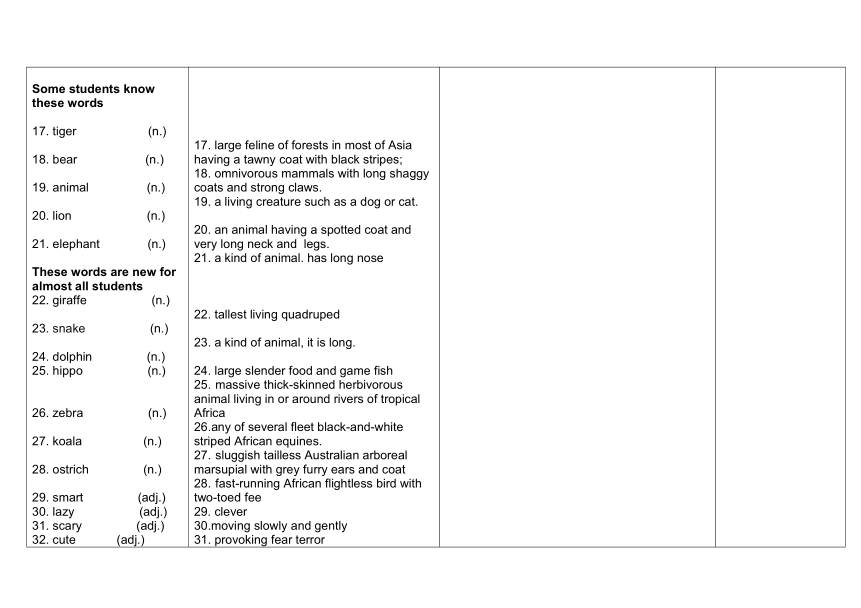Unit 5 Why do you like pandas? Speaking (表格式教案)
文档属性
| 名称 | Unit 5 Why do you like pandas? Speaking (表格式教案) |  | |
| 格式 | doc | ||
| 文件大小 | 332.7KB | ||
| 资源类型 | 教案 | ||
| 版本资源 | 人教新目标(Go for it)版 | ||
| 科目 | 英语 | ||
| 更新时间 | 2022-04-05 17:06:17 | ||
图片预览




文档简介
MXEC Lesson Plan
Information about the students in this class:The students are in Grade7. They are 13 or 14 years old. Their first language is Chinese. Most of them have been learning English for 4 or 6 years. Some of them have been known some animals. They have their personal feelings about different kinds of animals. But they find it is difficult to concentrate on speaking tasks.
Main aim:By the end of the lesson, students will be better able to speak accurately and fluently in the context of animals.Subsidiary aim:By the end of the lesson, students will be better able to use the new vocabulary in spoken form in the context of animals. Personal aim(s):Give students short and clear instructions.
Materials and their sources:1. Handout 1(match the words and pictures) is designed by teacher. The pictures, they are downloaded from the Internet.http://www./link url=http%3A%2F%2Fimage.%2Fv%3Fq%3D%25E7%2586%258A%25E7%258C%25AB%25E5%259B%25BE%25E7%2589%2587%26cmsid%3D9d78999355ccc932bb112e236c2f5494%26cmran%3D0%26cmras%3D0%26i%3D0%26cmg%3D5d7c9d41ebc59511e445558675f70028%26src%3D360pic_strong%26z%3D1%23multiple%3D0%26dataindex%3D4%26id%3Dca075b9c4a38cf564d66f5a4804f8ae8%26itemindex%3D0%26currsn%3D0%26gn%3D0%26cn%3D0%26kn%3D44&q=%E7%86%8A%E7%8C%AB%E5%9B%BE%E7%89%87&ts=1521482512&t=bddea87be7f1cb15fdb9a33c0acfb2a ( http: / / www. / link url=http%3A%2F%2Fimage.%2Fv%3Fq%3D%25E7%2586%258A%25E7%258C%25AB%25E5%259B%25BE%25E7%2589%2587%26cmsid%3D9d78999355ccc932bb112e236c2f5494%26cmran%3D0%26cmras%3D0%26i%3D0%26cmg%3D5d7c9d41ebc59511e445558675f70028%26src%3D360pic_strong%26z%3D1%23multiple%3D0%26dataindex%3D4%26id%3Dca075b9c4a38cf564d66f5a4804f8ae8%26itemindex%3D0%26currsn%3D0%26gn%3D0%26cn%3D0%26kn%3D44&q=%E7%86%8A%E7%8C%AB%E5%9B%BE%E7%89%87&ts=1521482512&t=bddea87be7f1cb15fdb9a33c0acfb2a )http://image./v q=%E9%95%BF%E9%A2%88%E9%B9%BF&cmsid=fbffb1993ff25621071ad8f47eb8b755&cmran=0&cmras=0&i=0&cmg=ee89f68e49fa6fee98dbe865077f78df&src=360pic_normal&z=1#id=17f4fc9a7ee083a9328c2b4d8f59a3d5&itemindex=0&currsn=0&jdx=4&gsrc=1&fsn=60&multiple=0&dataindex=4&prevsn=0 ( http: / / image. / v q=%E9%95%BF%E9%A2%88%E9%B9%BF&cmsid=fbffb1993ff25621071ad8f47eb8b755&cmran=0&cmras=0&i=0&cmg=ee89f68e49fa6fee98dbe865077f78df&src=360pic_normal&z=1#id=17f4fc9a7ee083a9328c2b4d8f59a3d5&itemindex=0&currsn=0&jdx=4&gsrc=1&fsn=60&multiple=0&dataindex=4&prevsn=0 )http://image./v q=%E9%AA%86%E9%A9%BC&cmsid=507f4a980850c0b0c3df54eaf30402d0&cmran=0&cmras=0&i=0&cmg=ee89f68e49fa6fee98dbe865077f78df&src=360pic_normal&z=1#id=052427be67998b86cc260f94ac81dafe&itemindex=0&currsn=0&jdx=8&gsrc=1&fsn=60&multiple=0&dataindex=8&prevsn=0 ( http: / / image. / v q=%E9%AA%86%E9%A9%BC&cmsid=507f4a980850c0b0c3df54eaf30402d0&cmran=0&cmras=0&i=0&cmg=ee89f68e49fa6fee98dbe865077f78df&src=360pic_normal&z=1#id=052427be67998b86cc260f94ac81dafe&itemindex=0&currsn=0&jdx=8&gsrc=1&fsn=60&multiple=0&dataindex=8&prevsn=0 )http://image./v q=%E8%80%81%E8%99%8E&cmsid=1ea74356c8dd31d359e709364959f050&cmran=0&cmras=0&i=0&cmg=ee89f68e49fa6fee98dbe865077f78df&src=360pic_normal&z=1#multiple=0&dataindex=2&id=0428b8ccac4769658e26708a050fc0b6&itemindex=0&currsn=0&gn=0&cn=0&kn=50 ( http: / / image. / v q=%E8%80%81%E8%99%8E&cmsid=1ea74356c8dd31d359e709364959f050&cmran=0&cmras=0&i=0&cmg=ee89f68e49fa6fee98dbe865077f78df&src=360pic_normal&z=1#multiple=0&dataindex=2&id=0428b8ccac4769658e26708a050fc0b6&itemindex=0&currsn=0&gn=0&cn=0&kn=50 )http://image./v src=360pic_normal&z=1&i=0&cmg=ee89f68e49fa6fee98dbe865077f78df&q=%E7%8C%B4%E5%AD%90&correct=%E7%8C%B4%E5%AD%90&cmsid=9fbfc4279ea94362ebe54803638562d8&cmran=0&cmras=0&cn=0&gn=0&kn=50#multiple=0&gsrc=1&dataindex=29&id=ca4369683f397356cbaa423b4fc56d2e&currsn=0&jdx=29&fsn=110 ( http: / / image. / v src=360pic_normal&z=1&i=0&cmg=ee89f68e49fa6fee98dbe865077f78df&q=%E7%8C%B4%E5%AD%90&correct=%E7%8C%B4%E5%AD%90&cmsid=9fbfc4279ea94362ebe54803638562d8&cmran=0&cmras=0&cn=0&gn=0&kn=50#multiple=0&gsrc=1&dataindex=29&id=ca4369683f397356cbaa423b4fc56d2e&currsn=0&jdx=29&fsn=110 )http://image./v q=%E7%86%8A&src=srp&correct=%E7%86%8A&cmsid=8169d13936ba08041c0ec14a64f98c03&cmran=0&cmras=0&cn=0&gn=0&kn=50#multiple=0&gsrc=1&dataindex=2&id=9c5b50b8d0a73dc2cd143296ad85ed30&currsn=0&jdx=2&fsn=110http://image./v q=south+africa&cmsid=6861f7f293f71859aa11485f6590de63&cmran=0&cmras=0&i=0&cmg=c749b09aa829ab36ff8235124ae232da&src=360pic_normal&z=1#id=192313b5c29d031065e17eabc7aa9114&itemindex=0&currsn=0&jdx=3&gsrc=1&fsn=60&multiple=0&dataindex=3&prevsn=0 ( http: / / image. / v q=south+africa&cmsid=6861f7f293f71859aa11485f6590de63&cmran=0&cmras=0&i=0&cmg=c749b09aa829ab36ff8235124ae232da&src=360pic_normal&z=1#id=192313b5c29d031065e17eabc7aa9114&itemindex=0&currsn=0&jdx=3&gsrc=1&fsn=60&multiple=0&dataindex=3&prevsn=0 )http://image./v src=360pic_strong&z=1&i=0&cmg=c749b09aa829ab36ff8235124ae232da&q=%E6%A0%91%E6%87%92%E5%9B%BE%E7%89%87&correct=%E6%A0%91%E6%87%92%E5%9B%BE%E7%89%87&cmsid=3ff5846fa26bcc87df896a52d1200aa0&cmran=0&cmras=0&cn=0&gn=0&kn=47#multiple=0&gsrc=1&dataindex=7&id=db297fc485e20199a70206907711b1c3&currsn=0&jdx=7&fsn=1072. The cards are made by the teacher.
Language analysis
Form Meaning Anticipated problems teaching this language Possible solutions
All students know these words 1. panda (n.)2. neck (n.) leg (n.) mouth (n.)eye (n.)ear (n.)tail (n.)long (adj.)short (adj.)big (adj.) small (adj.)zoo ( n.)interesting (adj.)fun (adj.)nice (adj.)beautiful (adj.)Some students know these words tiger (n.)bear (n.)animal (n.)lion (n.)elephant (n.)These words are new foralmost all studentsgiraffe (n.) snake (n.)dolphin (n.)hippo (n.)zebra (n.)koala (n.)ostrich (n.)smart (adj.)lazy (adj.)scary (adj.)cute (adj.)strong…….(adj.)Students will produce these sentences:Why don’t you like… Because they are…Why do you like … Because they are … Why does she/he like… Why doesn’t she/he like… Because they are … 1. large black and white mammals of bamboo forests of China.2. the part that connects the head to the rest of the body3. a limb between the knee and ankle. 4. the opening through which food is taken in and vocalizations emerge.5. the organ of sight.6. the sense organ for hearing.7. the posterior part of the body of a vertebrate beyond the main part of the body.8. being a relatively great or greater than average duration.9. indicating or being or seeming to be limited in duration.10. above average in size .11. limited or below average extent.12. the facility where wild animals are housed for exhibition.13. arousing or holding the attention14. a thing that gives enjoyment or pleasure and makes you feel happy15. pleasant or pleasing or agreeable in nature or appearance16. having beauty; pleasing to the senses or to the mind17. large feline of forests in most of Asia having a tawny coat with black stripes; 18. omnivorous mammals with long shaggy coats and strong claws.19. a living creature such as a dog or cat.20. an animal having a spotted coat and very long neck and legs. 21. a kind of animal. has long nose22. tallest living quadruped23. a kind of animal, it is long.24. large slender food and game fish25. massive thick-skinned herbivorous animal living in or around rivers of tropical Africa26.any of several fleet black-and-white striped African equines.27. sluggish tailless Australian arboreal marsupial with grey furry ears and coat28. fast-running African flightless bird with two-toed fee29. clever30.moving slowly and gently31. provoking fear terror32. lovely33. powerful Some students might spell giraffe wrongly as “giraffe”. Stick the word card for giraffe on the blackboard and point to it if I find a spelling mistake when monitoring.
Skills analysis
Skills and sub-skills Tasks for developing skills Anticipated problems with these tasks Possible solutions
Speaking for accuracy Speaking for fluency Guessing game: What’s this It’s…. Where are…from They’re from…Do you like … Why do/don’t you like ….Task 2. Give students a model, and the students use the pictures to practice with their partners. A: Do you like…B: Yes, I do. /No, I don’t.A: Why do you like … / Why don’t you like… B: Because they are…3. The students to design their own zoo, and then introduce the zoo to their group members. Students might describe the animals in Chinese.Maybe the know the new words. Remind them to describe them in English and monitoring.Move on, focus on the speaking.
Stage no. and name Stage aim Procedure Interaction pattern Time
1.lead in To lead in the topic (animals) Set up the topic “animals “Show parts of the panda’s picture, ask students: What‘s this … Do you like pandas Why do you like pandas Because they are…Why don’t you like pandas Because they are…T: So today’s topic is Ss: “animals” T-Ss Ss-T 2 minutes
2. Review To review the words about the animals and the personal feelings of each kind of animal. Students talk to their partners about the other animals.Like or don't like. Why Where are they from Ss-Ss 2 minutes
3. Present the new words Show the pictures and present the new words, practice the pronunciation. Using pictures to convey the meaning of new words: giraffe dolphin zebra hippo koala ostrich Using body language and picture to convey the meaning of lazy scary cute strongUsing synonyms for clever to convey meaning of smart Use drilling to practice the pronunciation of the new vocabulary. Ask good CCQs to check the meaning. T-Ss, Ss-T 10 minutes
4. Checking activities Check the meaning of the new words. 1. Teacher gives students the pictures, work in pairs. Covered and guess “What’s this It’s….2. Show the words and do the actions to check the adjective words. Ss-Ss 3 minutes
5. Practice To give students an opportunity to speak accurately Task 2: make a freer dialogue (there are some pictures and models for the students) A: Do you like…B: Yes, I like…. /No, I don’t like ….A: Why do you like … / Why don’t you like… B: I like… because they are… Ss-Ss 6 minutes
6. Feed back Question for other students: What does she like Why does she like Two pairs show their dialogues. Ss-Ss 2 minutes
7. Practise Using the new vocabulary in spoken forms. Put the pictures in the middle of the desk choose and say it one by one.A: Do you like… B: Yes, I like…/No, I don’t like…, because they are….C: Why does she/he like… / Why doesn’t she/ he like… D: Because they are… Ss-Ss 6 minutes
8. Final Feedback Speaking accurately and fluently with the new vocabulary. Do a surveyTen have a report in the group. S-Ss 8 minutes
附:Handout
Task 1.Make a dialogue with your partners (use the pictures)
A: Do you like…
B: Yes, Ilike… /No, I don’t like ….
A: Why do you like … / Why don’t you like…
B: Because they are….
Task2. Group work
A: Do you like…
B: Yes, I like…/No, I don’t like…, because they are….
C: Why does she/he like… / Why doesn’t she/ he like…
D: Because they are…
Task 3 . Do a survey
Name:_____Why do you like giraffes
Name:_____Why don’t you like hippos
PAGE
Information about the students in this class:The students are in Grade7. They are 13 or 14 years old. Their first language is Chinese. Most of them have been learning English for 4 or 6 years. Some of them have been known some animals. They have their personal feelings about different kinds of animals. But they find it is difficult to concentrate on speaking tasks.
Main aim:By the end of the lesson, students will be better able to speak accurately and fluently in the context of animals.Subsidiary aim:By the end of the lesson, students will be better able to use the new vocabulary in spoken form in the context of animals. Personal aim(s):Give students short and clear instructions.
Materials and their sources:1. Handout 1(match the words and pictures) is designed by teacher. The pictures, they are downloaded from the Internet.http://www./link url=http%3A%2F%2Fimage.%2Fv%3Fq%3D%25E7%2586%258A%25E7%258C%25AB%25E5%259B%25BE%25E7%2589%2587%26cmsid%3D9d78999355ccc932bb112e236c2f5494%26cmran%3D0%26cmras%3D0%26i%3D0%26cmg%3D5d7c9d41ebc59511e445558675f70028%26src%3D360pic_strong%26z%3D1%23multiple%3D0%26dataindex%3D4%26id%3Dca075b9c4a38cf564d66f5a4804f8ae8%26itemindex%3D0%26currsn%3D0%26gn%3D0%26cn%3D0%26kn%3D44&q=%E7%86%8A%E7%8C%AB%E5%9B%BE%E7%89%87&ts=1521482512&t=bddea87be7f1cb15fdb9a33c0acfb2a ( http: / / www. / link url=http%3A%2F%2Fimage.%2Fv%3Fq%3D%25E7%2586%258A%25E7%258C%25AB%25E5%259B%25BE%25E7%2589%2587%26cmsid%3D9d78999355ccc932bb112e236c2f5494%26cmran%3D0%26cmras%3D0%26i%3D0%26cmg%3D5d7c9d41ebc59511e445558675f70028%26src%3D360pic_strong%26z%3D1%23multiple%3D0%26dataindex%3D4%26id%3Dca075b9c4a38cf564d66f5a4804f8ae8%26itemindex%3D0%26currsn%3D0%26gn%3D0%26cn%3D0%26kn%3D44&q=%E7%86%8A%E7%8C%AB%E5%9B%BE%E7%89%87&ts=1521482512&t=bddea87be7f1cb15fdb9a33c0acfb2a )http://image./v q=%E9%95%BF%E9%A2%88%E9%B9%BF&cmsid=fbffb1993ff25621071ad8f47eb8b755&cmran=0&cmras=0&i=0&cmg=ee89f68e49fa6fee98dbe865077f78df&src=360pic_normal&z=1#id=17f4fc9a7ee083a9328c2b4d8f59a3d5&itemindex=0&currsn=0&jdx=4&gsrc=1&fsn=60&multiple=0&dataindex=4&prevsn=0 ( http: / / image. / v q=%E9%95%BF%E9%A2%88%E9%B9%BF&cmsid=fbffb1993ff25621071ad8f47eb8b755&cmran=0&cmras=0&i=0&cmg=ee89f68e49fa6fee98dbe865077f78df&src=360pic_normal&z=1#id=17f4fc9a7ee083a9328c2b4d8f59a3d5&itemindex=0&currsn=0&jdx=4&gsrc=1&fsn=60&multiple=0&dataindex=4&prevsn=0 )http://image./v q=%E9%AA%86%E9%A9%BC&cmsid=507f4a980850c0b0c3df54eaf30402d0&cmran=0&cmras=0&i=0&cmg=ee89f68e49fa6fee98dbe865077f78df&src=360pic_normal&z=1#id=052427be67998b86cc260f94ac81dafe&itemindex=0&currsn=0&jdx=8&gsrc=1&fsn=60&multiple=0&dataindex=8&prevsn=0 ( http: / / image. / v q=%E9%AA%86%E9%A9%BC&cmsid=507f4a980850c0b0c3df54eaf30402d0&cmran=0&cmras=0&i=0&cmg=ee89f68e49fa6fee98dbe865077f78df&src=360pic_normal&z=1#id=052427be67998b86cc260f94ac81dafe&itemindex=0&currsn=0&jdx=8&gsrc=1&fsn=60&multiple=0&dataindex=8&prevsn=0 )http://image./v q=%E8%80%81%E8%99%8E&cmsid=1ea74356c8dd31d359e709364959f050&cmran=0&cmras=0&i=0&cmg=ee89f68e49fa6fee98dbe865077f78df&src=360pic_normal&z=1#multiple=0&dataindex=2&id=0428b8ccac4769658e26708a050fc0b6&itemindex=0&currsn=0&gn=0&cn=0&kn=50 ( http: / / image. / v q=%E8%80%81%E8%99%8E&cmsid=1ea74356c8dd31d359e709364959f050&cmran=0&cmras=0&i=0&cmg=ee89f68e49fa6fee98dbe865077f78df&src=360pic_normal&z=1#multiple=0&dataindex=2&id=0428b8ccac4769658e26708a050fc0b6&itemindex=0&currsn=0&gn=0&cn=0&kn=50 )http://image./v src=360pic_normal&z=1&i=0&cmg=ee89f68e49fa6fee98dbe865077f78df&q=%E7%8C%B4%E5%AD%90&correct=%E7%8C%B4%E5%AD%90&cmsid=9fbfc4279ea94362ebe54803638562d8&cmran=0&cmras=0&cn=0&gn=0&kn=50#multiple=0&gsrc=1&dataindex=29&id=ca4369683f397356cbaa423b4fc56d2e&currsn=0&jdx=29&fsn=110 ( http: / / image. / v src=360pic_normal&z=1&i=0&cmg=ee89f68e49fa6fee98dbe865077f78df&q=%E7%8C%B4%E5%AD%90&correct=%E7%8C%B4%E5%AD%90&cmsid=9fbfc4279ea94362ebe54803638562d8&cmran=0&cmras=0&cn=0&gn=0&kn=50#multiple=0&gsrc=1&dataindex=29&id=ca4369683f397356cbaa423b4fc56d2e&currsn=0&jdx=29&fsn=110 )http://image./v q=%E7%86%8A&src=srp&correct=%E7%86%8A&cmsid=8169d13936ba08041c0ec14a64f98c03&cmran=0&cmras=0&cn=0&gn=0&kn=50#multiple=0&gsrc=1&dataindex=2&id=9c5b50b8d0a73dc2cd143296ad85ed30&currsn=0&jdx=2&fsn=110http://image./v q=south+africa&cmsid=6861f7f293f71859aa11485f6590de63&cmran=0&cmras=0&i=0&cmg=c749b09aa829ab36ff8235124ae232da&src=360pic_normal&z=1#id=192313b5c29d031065e17eabc7aa9114&itemindex=0&currsn=0&jdx=3&gsrc=1&fsn=60&multiple=0&dataindex=3&prevsn=0 ( http: / / image. / v q=south+africa&cmsid=6861f7f293f71859aa11485f6590de63&cmran=0&cmras=0&i=0&cmg=c749b09aa829ab36ff8235124ae232da&src=360pic_normal&z=1#id=192313b5c29d031065e17eabc7aa9114&itemindex=0&currsn=0&jdx=3&gsrc=1&fsn=60&multiple=0&dataindex=3&prevsn=0 )http://image./v src=360pic_strong&z=1&i=0&cmg=c749b09aa829ab36ff8235124ae232da&q=%E6%A0%91%E6%87%92%E5%9B%BE%E7%89%87&correct=%E6%A0%91%E6%87%92%E5%9B%BE%E7%89%87&cmsid=3ff5846fa26bcc87df896a52d1200aa0&cmran=0&cmras=0&cn=0&gn=0&kn=47#multiple=0&gsrc=1&dataindex=7&id=db297fc485e20199a70206907711b1c3&currsn=0&jdx=7&fsn=1072. The cards are made by the teacher.
Language analysis
Form Meaning Anticipated problems teaching this language Possible solutions
All students know these words 1. panda (n.)2. neck (n.) leg (n.) mouth (n.)eye (n.)ear (n.)tail (n.)long (adj.)short (adj.)big (adj.) small (adj.)zoo ( n.)interesting (adj.)fun (adj.)nice (adj.)beautiful (adj.)Some students know these words tiger (n.)bear (n.)animal (n.)lion (n.)elephant (n.)These words are new foralmost all studentsgiraffe (n.) snake (n.)dolphin (n.)hippo (n.)zebra (n.)koala (n.)ostrich (n.)smart (adj.)lazy (adj.)scary (adj.)cute (adj.)strong…….(adj.)Students will produce these sentences:Why don’t you like… Because they are…Why do you like … Because they are … Why does she/he like… Why doesn’t she/he like… Because they are … 1. large black and white mammals of bamboo forests of China.2. the part that connects the head to the rest of the body3. a limb between the knee and ankle. 4. the opening through which food is taken in and vocalizations emerge.5. the organ of sight.6. the sense organ for hearing.7. the posterior part of the body of a vertebrate beyond the main part of the body.8. being a relatively great or greater than average duration.9. indicating or being or seeming to be limited in duration.10. above average in size .11. limited or below average extent.12. the facility where wild animals are housed for exhibition.13. arousing or holding the attention14. a thing that gives enjoyment or pleasure and makes you feel happy15. pleasant or pleasing or agreeable in nature or appearance16. having beauty; pleasing to the senses or to the mind17. large feline of forests in most of Asia having a tawny coat with black stripes; 18. omnivorous mammals with long shaggy coats and strong claws.19. a living creature such as a dog or cat.20. an animal having a spotted coat and very long neck and legs. 21. a kind of animal. has long nose22. tallest living quadruped23. a kind of animal, it is long.24. large slender food and game fish25. massive thick-skinned herbivorous animal living in or around rivers of tropical Africa26.any of several fleet black-and-white striped African equines.27. sluggish tailless Australian arboreal marsupial with grey furry ears and coat28. fast-running African flightless bird with two-toed fee29. clever30.moving slowly and gently31. provoking fear terror32. lovely33. powerful Some students might spell giraffe wrongly as “giraffe”. Stick the word card for giraffe on the blackboard and point to it if I find a spelling mistake when monitoring.
Skills analysis
Skills and sub-skills Tasks for developing skills Anticipated problems with these tasks Possible solutions
Speaking for accuracy Speaking for fluency Guessing game: What’s this It’s…. Where are…from They’re from…Do you like … Why do/don’t you like ….Task 2. Give students a model, and the students use the pictures to practice with their partners. A: Do you like…B: Yes, I do. /No, I don’t.A: Why do you like … / Why don’t you like… B: Because they are…3. The students to design their own zoo, and then introduce the zoo to their group members. Students might describe the animals in Chinese.Maybe the know the new words. Remind them to describe them in English and monitoring.Move on, focus on the speaking.
Stage no. and name Stage aim Procedure Interaction pattern Time
1.lead in To lead in the topic (animals) Set up the topic “animals “Show parts of the panda’s picture, ask students: What‘s this … Do you like pandas Why do you like pandas Because they are…Why don’t you like pandas Because they are…T: So today’s topic is Ss: “animals” T-Ss Ss-T 2 minutes
2. Review To review the words about the animals and the personal feelings of each kind of animal. Students talk to their partners about the other animals.Like or don't like. Why Where are they from Ss-Ss 2 minutes
3. Present the new words Show the pictures and present the new words, practice the pronunciation. Using pictures to convey the meaning of new words: giraffe dolphin zebra hippo koala ostrich Using body language and picture to convey the meaning of lazy scary cute strongUsing synonyms for clever to convey meaning of smart Use drilling to practice the pronunciation of the new vocabulary. Ask good CCQs to check the meaning. T-Ss, Ss-T 10 minutes
4. Checking activities Check the meaning of the new words. 1. Teacher gives students the pictures, work in pairs. Covered and guess “What’s this It’s….2. Show the words and do the actions to check the adjective words. Ss-Ss 3 minutes
5. Practice To give students an opportunity to speak accurately Task 2: make a freer dialogue (there are some pictures and models for the students) A: Do you like…B: Yes, I like…. /No, I don’t like ….A: Why do you like … / Why don’t you like… B: I like… because they are… Ss-Ss 6 minutes
6. Feed back Question for other students: What does she like Why does she like Two pairs show their dialogues. Ss-Ss 2 minutes
7. Practise Using the new vocabulary in spoken forms. Put the pictures in the middle of the desk choose and say it one by one.A: Do you like… B: Yes, I like…/No, I don’t like…, because they are….C: Why does she/he like… / Why doesn’t she/ he like… D: Because they are… Ss-Ss 6 minutes
8. Final Feedback Speaking accurately and fluently with the new vocabulary. Do a surveyTen have a report in the group. S-Ss 8 minutes
附:Handout
Task 1.Make a dialogue with your partners (use the pictures)
A: Do you like…
B: Yes, Ilike… /No, I don’t like ….
A: Why do you like … / Why don’t you like…
B: Because they are….
Task2. Group work
A: Do you like…
B: Yes, I like…/No, I don’t like…, because they are….
C: Why does she/he like… / Why doesn’t she/ he like…
D: Because they are…
Task 3 . Do a survey
Name:_____Why do you like giraffes
Name:_____Why don’t you like hippos
PAGE
同课章节目录
- Unit 1 Can you play the guitar?
- Section A
- Section B
- Unit 2 What time do you go to school?
- Section A
- Section B
- Unit 3 How do you get to school?
- Section A
- Section B
- Unit 4 Don't eat in class.
- Section A
- Section B
- Unit 5 Why do you like pandas?
- Section A
- Section B
- Unit 6 I'm watching TV.
- Section A
- Section B
- Review of Units 1-6
- Unit 7 It's raining!
- Section A
- Section B
- Unit 8 Is there a post office near here?
- Section A
- Section B
- Unit 9 What does he look like?
- Section A
- Section B
- Unit 10 I'd like some noodles.
- Section A
- Section B
- Unit 11 How was your school trip?
- Section A
- Section B
- Unit 12 What did you do last weekend?
- Section A
- Section B
